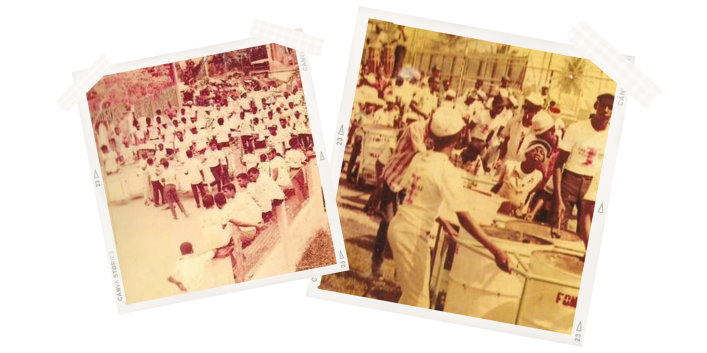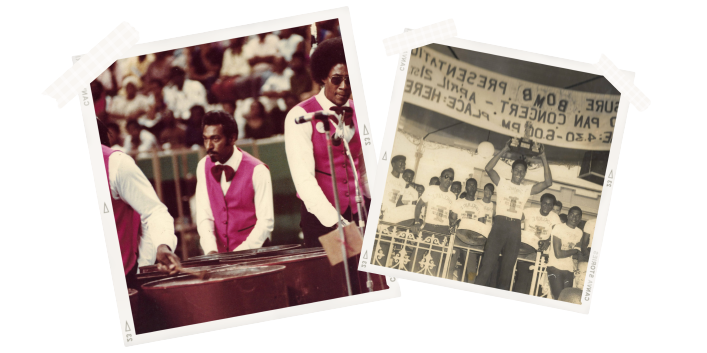The Formative Years:
Forging a Community Spirit 1955-1965
Welcome to the “Hole”
The years spanning 1955-1965 gave birth to a community in the Borough of San Fernando that was like no other. The boundaries of that community, in the beginning, were Coffee Street to the North, Bertrand to the East, Rushworth to the South and Drayton to the West assuming San Fernando Hill to be due North. The streets Claire, Fonrose, Dottin, Cooper, Austin, Parry, Thorne and Legendre were internal to those boundaries. It would be instructive to identify at once, for the benefit of the reader, that the physical space delimited by the latter streets came to be known as “The Hole,” reason being that for one to actually get out to other parts of San Fernando one had to climb a steep hill.
The societal make-up of the Hole during the decade 1955-1965 comprised a multitude of families reflecting the rainbow diversity of the country. Our community at that time was teeming with children and teenagers of all ethnicities, religions and skin tone; African, East Indian, Chinese, Caucasian, Anglican, Roman Catholic, Seven Day Adventists, Presbyterian, Hindu, Muslim. Fonrose, Claire, Austin, Dottin, Cooper and Parry Streets were their playground where football, cricket, spinning top, flying kite, tin-pan, down-hill cart and scooter racing could be seen on any given day. Table tennis, pitching marbles and climbing the large variety of fruit trees in our neighbors’ yards also occupied their free time. All homes were open to the children and the mothers and fathers of those homes treated all the children as their own. The Hole was one big melting pot where everyone respected each other regardless of colour, creed, race or religion and we were one big happy family living in it. Therein lay the foundation of Community Spirit, the very foundation on which Fonclaire would be built.
Apart from having a strong bonding influence on the families living there, the “Hole” was also blessed with economic and commercial activity that provided sustenance for the immediate community and services for a far wider catchment area. There were two Chinese shops, Tang on Claire Street and Madame Lee on Cooper Street where, as poor families we were allowed to purchase on credit. Then there were the small business establishments which provided the youth with employment opportunities to learn a trade. Swanson’s Autobody Repair and Painting at the corner of Claire and Fonrose Streets, Scotty’s Motor Vehicle Maintenance conducted on Dottin Street, Peter’s Autobody Repair at the corner of Cooper and Thorne Streets, the Lai-Hings Mechanical Services on the “Concrete” specifically for Volks Wagon only. Sonny Boy Jumrattie’s Fonclaire Peace Grounds, a beer garden where the youth gathered to drink beer, play music on the Jukebox and, last but not least admire his beautiful daughters, came into prominence in the late sixties. A lot of the pop music the band played came from that Jukebox.
The ‘Hole” was a centre of social and economic activity that attracted many people and when those people came to our community, they did not leave. They became part and parcel of our little piece of Paradise. Our community would go on in future years to spread its tentacles far and wide to include Pleasantville and other areas outside the Borough of San Fernando. And with the formation of the steel-band the community’s connectivity expanded to include people from Marabella and as far as Couva in the north, Princes Town and Moruga in the east and La Brea and Point Fortin further south.
In the early 60’s before the band was formed the youth of the community competed in Sunday Morning Football in Skinner Park under the name Fonclaire. All or most of the players came from Fonrose Street and Claire Street hence the name Fonclaire which served to unify even further the energies of youth living on those two streets. We also competed in a football League Competition in Golconda. We held parties and other functions in Swanson’s Garage. The Fonclaire identity, therefore, was established to give life to a social, cultural and sporting movement that existed in the “Hole” long before the first notes of the band were struck in 1965.
The Birth Of Fonclaire
Passion and Providence Collide: 1964-65

The year 1964 was the year when the first tuned steel drums came into the community. They included one tenor, one double tenor, one 3-Cello and one Grundig (now called Guitar Pan); throw-aways from some existing band. They were deposited under Mervyn Scott’s (Scotty) house and there is where it all began. Mr. Hatim Lalla, 6 Base player of many, many years service on the Panorama and Road Side and who still plays cow bell with the band was one of the bigger boys at the time and remembers those times:
“Lennox Gonsalves (deceased) also known as “Terracutter” who lived on Drayton Street was a steel band man from Melody Makers who could play. He checked out the pans and told us they were rusted and out of tune.” Wire did not belong to our community at that time. His affiliation was with Trinidad Maestros, a well established steel band located in Mon Repos, San Fernando. He hung out with that bunch. It didn’t matter that the pans were rusted and out of tune. For a community of youth filled with passion for the instrument and realizing, for the first time, the possibility of actually striking notes and hearing the sound in our own backyard, four instruments could never have been enough. In that scenario the big boys always had first swing while younger ones usually looked on. Hatim recollects that some of the big boys who had access at that time included Mikey King, Leslie Fenton, Roland Imrie, Kenneth Arthur, Michael Austin, Ashton Haynes, Mervyn Vance, Austin Swanson, himself and others. Every now and again a little red boy named Rudin Austin would get a play when the big boys were not around.
As fate would have it, Wire’s connection with Maestros steelband was severed in 1964 when Steve Lalsingh, its leader was killed in a vehicular accident on the San Fernando Bypass. Other members of the band were seriously injured. The death of Mr. Lalsingh resulted in the almost abrupt end to Maestros as the pan yard was at Mr. Lalsingh’s home. A combination of no place to practice and death of the leader spelt the death knell of Trinidad Maestros. Wire would then become, as we call it today, a free agent with steelband experience and no steelband to play in. And so it was that passion and providence collided in 1964 when some of the big boys of our community, including Hatim, approached him to help them form a steel band in our area. What actually motivated him to help us form a steelband from scratch is anybody’s guess. He had already decided at the time to quit steelband, marry the woman of his dreams and settle down. However, as soon as he agreed and the decision was made, our community mobilized every resource possible to make it happen. Hatim Lalla recollects:
We then embarked on a fund raising venture. This was fully supported by the people of the area. Car excursions, raffles, Bingo, cake sales, individual donations were all very useful in providing money for the purchase of drums and paying the tuner.
Fonclaire is Born:
The Early Years 1965 -1970, the Soul Band

The year 1965 was a watershed year for our community. It was the first point of inflexion on an upward trend which saw a loose aggregation of young men in the “Hole” achieve, within less than two years, the formation of a fledgling steel orchestra. Inspired by the sound of the drum and passionate enough to dream of a bright, new endeavour and future, they threw every ounce of their energy and talents into making this dream a reality. When one thinks back on the period 1964/1965, one cannot but recognize in retrospect, the amazing feat that was accomplished. One cannot but admire the organizational ability and industry of the community elders and Tradesmen/Builders who were also instrumental in making that happen. At this juncture it would be appropriate to mention the names of some of them, many of whom have long ago transitioned to a better place.
The Elders / Founding Fathers
Mr. David Swanson Sr.
Mr. Lisle Austin
Mr. Daniel Lalla
Mr. Josiah Watson
Mr. Mervyn Scott
Mr. Knolly Huggins
Mr. Kenneth “Golab” Belgrove
Mr. Mickey Cardinal
Mr. Sonny “Boy” Jumrattie
Mr. Carrie Greenidge
The Tradesmen/Builders of the first set of Rolling Stands for Panorama 1967 and the Road during Carnival:
Mr. Michael Salvador (top class double tenor player and Fabricator), Jerry Holas (Low Tenor player and welder), Ruthven Roach (Guitar player and welder). “Mr. Peters of Peters Machine Shop gave us access to his machines and welding plant free of charge,” Hatim Lalla remembers. “All we had to buy was the pipes that were neded. That style of base stands we have kept until the present time.” All thanks to the creative genius of Michael Salvador and his Team of skilled Tradesmen mentioned above. We owe them a debt of gratitude that can never be repaid. According to Hatim,
Some of the Elders played a major role having formed a disciplinary committee to treat with any disagreements between members of the Band. Fortunately, they had little or no work to do as the members were very together and exercised mutual respect for each other.
It should be mentioned here that it was Mr. Mickey Cardinal who suggested that the Band be called “Fonclaire.” Hatim recollected that Mickey entered the gambling room downstairs Scotty’s house to find them arguing over a name for the band. In those days many bands chose the titles of movies to identify themselves with such as Invaders, Desperadoes, Renegades etc. Apart from that there were two groups of youth in the community that identified themselves as Herons and Thunderbirds and they sported long sleeve jerseys to showcase their identities. He suggested that instead of coming up with a new name why not use the name the community already played sport under, i.e. Fonclaire. And that suggestion, coming from a man who was well respected in the community, was adopted and the Band would be forever known as Fonclaire.
The community now armed with sufficient funds and drums, mandated Wire to contact the master tuner Alan Gervais and his assistant Errol Moore who, bright and early one morning came to do their thing in Scotty’s back yard. The picture of those two men pounding away at the flat side of the drum to make a concave bowl, marking out the notes and then grooving the edges to provide separation, cutting the skirt to fit the particular instrument to be tuned, firing up the wood furnace, heating the grooved face of the truncated drum and finally tuning the instrument note by note when the drum had cooled, will remain indelibly etched in the memories of those who were fortunate to have been there.
The first set of pans included:
2- 5 bass, 2- double seconds, 2- grundigs (now called guitar pans), 3-low tenors.
Some of the First Stage Side Members:
– 5 Bass: Milton “Wire” Austin & Kenneth “Sharkhead” Arthur
- 4 Bass: Kenny “Renegade” Jumrattie
- Low Bass: Burke Lai Hing
- 3 Cello: Leslie Fenton
- Grundig (now called Guitar): Roger “Baggy” Austin, Austin Swanson, Ruthven “Cosmos” Roach, Rolston “Blues” Arthur
- Double Second: Mervyn Swanson, Eddie Samuel, Steve “Party Steve” Simon, Glen Long, Carlton Chrystom, Raphael “Raphie”Passy, Cleve Black
- Double Tenor: Michael Austin, Michael Salvador, Mervyn “Satan Bug” Vance, Arnold Cooper
- Low Tenor: Rudin “Redman” Austin, Vincent “Tambie” Swanson, David Swanson Jr., Jerry Holas, Boston Kallicharan, Anthony “Buttards” Bartholomew, Clinton “Underworld” Arnette, Selwyn Nicholas, Victor Reed, Andy Williams
Rhythm Section:
- Timbales and Cowbell, full drum set: Nolan Barker
- Tumba: Ancil Swanson, Ernleigh “Bust up Tumba” Roach (and later on till 1975 (Drums)
- Drums: Raphie Passey (drums during Meters era up to 1970)
- Tambourine: Eddie Lawerance
Not every member had it easy with their families during this time. For instance, Hatim remembers that Burke Lai Hing and Nolan Barker had to disguise themselves while playing so that their families would not recognize them. The location for the pan yard would be Scotty’s back yard. It should be noted here that the success of our band was, in large measure due to Scotty’s decision to allow us to practice in his yard. We have been very fortunate to have had a fixed place of abode from 1965 to the present day thanks to Mr. Mervyn Scott, his sister Emerald and wife Lystra, and “Chooks” who ran a game in a small room downstairs of the home in which all of them lived.
This list is not exhaustive and not all the members were in the Band at the same time. One can say this list represents the Fonclaire of the 60’s. This period 1965-1970 was a very active time for the Band as we played in many charity events, concerts and performances in Naparima Bowl and on the Band Stand, Harris Promenade. This is when the “Soul Band” accolade was attached to our name having started a collaboration with a singing group called “The Imperials” from Mon Repos. But that part of the Story is for another time.
